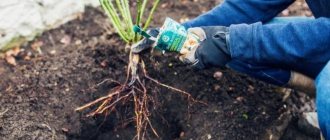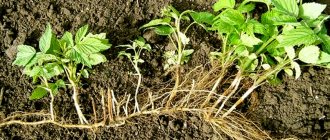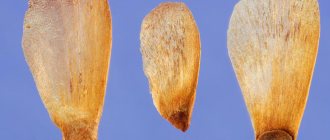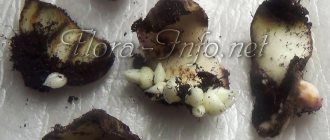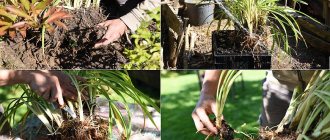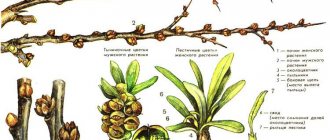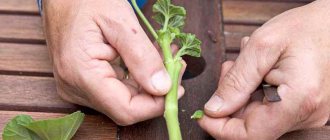Dividing dahlias
Reproduction of dahlias by dividing tubers allows you to preserve the varietal characteristics of the mother bush. Division is carried out in the fall before storing the dahlia, while the cuttings have not yet had time to tighten, or in the spring before planting.
When a steady cold snap sets in, trim the stems of the bush, leaving stumps a few centimeters long, and dig up the rhizome. Then wash thoroughly in water and let dry, discard damaged and underdeveloped tubers.
Divide the stem stump with your hands (if necessary, cut it) so that each division (planting unit) has one tuber with 1-2 buds on the root collar. If you need more planting material, take a quality tuber and cut it lengthwise so that there is one growth bud on each half. For weak rhizomes, you need to leave 2-3 tubers per division.
It is recommended to divide the tubers annually, as this procedure rejuvenates the plant, preventing the inflorescences from being crushed.
Timing and rules for planting tubers for cuttings
All varieties of the crop are characterized by low frost resistance, so the underground part of the plant is not left in the ground until the next season. The tubers are dug up and brought indoors for storage. The work is carried out after the first frost. About half a month before the temperature drops, stop watering. During this time, the root system will mature and enter the dormant phase.
The dug roots are dried, carefully inspected, and dry and damaged areas are removed.
Attention! Before removing dahlias from the soil for further cuttings, I shorten the stems to 8 cm, dig them up, and shake off the remaining soil or wash it off with water.
The underground part of dahlias consists of several tuberous compactions with thin root threads. The tubers are attached to the stem, the place where they join is called the root collar. Replacement buds are formed on it. In order for them to start growing and produce cuttings that can be used to propagate dahlias on the site in the spring, the root must first be prepared.
If the root system is overgrown and voluminous, it is divided into several parts, taking into account that each fragment contains 1–2 full-fledged tubers, the same number of vegetative buds and a neck. To take cuttings from dahlias in the spring, the tubers need preliminary germination so that the buds wake up in the spring and resume the growing season. The procedure is carried out approximately in early March; the second half of February is suitable for the south. The following activities are required:
- For germination, take wide or small containers, flower pots, and wooden containers.
- Mix peat with sand or sawdust in equal proportions, fill containers with substrate and water with manganese solution.
- The root is deepened so that the cut stem and vegetative buds remain on the surface.
- The soil is no longer moistened, the containers are covered with film and placed in a lighted place. Germinate at a temperature of +22 C. Every day, the covering material on one side is raised for ventilation.
Read more Pinching and pinching dahlias - video, photo
Sprouts will appear in about 15–20 days.
Advice! If there are several varieties, a tag with the name of the dahlia is attached to each package.
Propagation of dahlias by grafting
Grafting is a rather troublesome process, and therefore not very popular among gardeners. Nevertheless, dahlia bushes obtained in this way bloom earlier and by autumn grow larger tubers than cuttings.
For grafting, take the healthy tubers remaining after division that are unsuitable for planting, and a cutting of the desired variety. Wash the tuber thoroughly, dry it and cut a conical hole in it. Sharpen the lower part of the cutting with a knife, also giving it a conical shape, and insert it into the hole of the tuber.
Wrap the grafting site tightly with a cotton or woolen rope and plant the tuber and cuttings in the soil. The beneficial substances contained in the tuber will provide the cutting with strength, and pretty soon you will get a lush bush.
You can also vaccinate an adult plant:
- Using a clean, sharp knife, cut the stem of the rootstock (mother bush) at the desired height and make a split in it;
- on the scion (cutting of the desired variety), make a small wedge-shaped cut;
- insert the cutting into the split so that its cambium (a thin strip of tissue located under the bark) is connected to the cambium of the rootstock;
- Wrap a long cotton band tightly around the grafting site;
- Dip the end of the tourniquet into water - this will help maintain the desired level of humidity.
After 7-10 days, carefully inspect the scion, but do not unwind the binding so as not to harm the plant. By this time the cutting should have taken root. If this does not happen, the scion will dry out or rot.
It is recommended to remove the tourniquet no earlier than after 1-1.5 months. Next season you will be able to see the result of such grafting, but there is a risk that the color of the resulting dahlia will not be as bright as that of the mother bush.
Caring for cuttings
It is better to take transparent containers for cuttings so that you can see when the roots begin to grow. After the root threads are formed, the film is removed. Subsequent care of seedlings consists of the following activities.
- The containers are placed on the windowsill. Windows facing south or east are suitable.
- Water moderately to prevent waterlogging and drying out of the soil.
- They feed with organic matter immediately after removing the covering material, after two weeks they add complex mineral fertilizers, and be sure to include nitrogen.
20 days before transplanting to the site, the plant is hardened by gradually lowering the temperature to +15 C. To prevent tall shoots from becoming deformed, a fixing support is installed. You can take the seedlings out onto the balcony or loggia for several hours in a shaded place. Every day they increase their time spent in the fresh air. The plant adapts to the environment and will more easily tolerate transplanting into a flower bed.
Read more Low-growing (border) varieties of dahlias with photos and names: growing from seeds, planting, care, photos
Growing dahlias from seeds
Seed propagation is an excellent way to get unexpected, interesting specimens, because growing dahlia from seeds at home excludes the possibility of the new plant retaining the varietal characteristics of the mother bush.
Cut off the inflorescences with set seeds in the fall and hang them to ripen in a ventilated, dry room. When the seeds are ripe, remove them from the inflorescences, dry them well, and in March you can sow them for seedlings.
If there are too early persistent frosts, cut off the inflorescences with a long stem, place them in water and leave to ripen in a bright, warm place, periodically changing the liquid in the vessel.
Cuttings of dahlias
The advantage of cuttings is that it increases the plant's disease resistance and accelerates its growth rate. The flowers of such dahlias are larger, and the tubers are of high quality.
In order to carry out cuttings, in the second half of March, take high-quality dahlia tubers and place them in a box, sprinkled with loose soil so that the root neck of the tuber remains open. Keep the soil moist by watering it regularly. The temperature in the room should be 20-25⁰С, but after the sprouts appear, reduce it to 15-17⁰С, reduce watering, and move the box to a well-lit place. In cloudy weather, be sure to add light to the dahlias.
When the shoots form 2-3 internodes and grow to 7-12 cm, cut the cuttings, leaving on the tuber a part of the stem with a pair of leaves, from which new shoots will later develop.
After cutting the cutting, the dahlia tuber can be planted in the ground, or you can continue growing other cuttings on it. For rooting, select cuttings with short internodes and prepare a box with 2-3 cm of gravel on the bottom (for drainage), and then 7-10 cm of coarse sand or perlite, and spill with water.
Cuttings can be pre-treated with a growth stimulant, for example, Kornevin: powder the cut areas to a height of no more than 1 cm with it or dip it in the powder itself. Lightly shake off the cuttings and plant them in a box at a distance of 5-7 cm, deepening them by 2-3 cm.
For 10-20 days, keep the substrate moist and spray the cuttings with water, shading them from direct sunlight. The optimal temperature for rooting dahlias is 18-22⁰С. You can cover the box with film, but in this case, do not forget to ventilate the greenhouse 1-2 times a day.
When the cuttings take root, plant them in pots. If a stimulator was used, rooting occurs in about a week. With earlier cuttings (January-February), the process will take 3-4 weeks. In general, you can get 10-25 cuttings from one tuber in a month.
Site selection and preparation
Heat-loving dahlias are easily damaged even by minor frosts, so lowlands with stagnant moisture and poor air circulation are not suitable for them. They grow best on flat or elevated areas where there are no through winds - the fragile stems break in strong winds.
It is not recommended to plant them next to buildings, fences, or close to tall trees, since lack of light (less than 6 hours a day) causes the flowers to become smaller and the color richness is lost. In areas where the groundwater level is less than 1 m, moisture stagnation is observed, the tubers begin to hurt, the supply of nutrients is disrupted, and the bush dies. In this case, if there is no choice, high embankment ridges are built.
The place for the ridges, flower beds are prepared in the fall - they dig them up (depth 30-35 cm), add rotted manure (10-15 kg/1 m²), potassium sulfate and superphosphate (1 tbsp./1 m²). In May, when there are 2-3 weeks left before planting, they dig again, but to a depth of 20-25 cm, adding wood ash (2-3 tbsp), Agricola and urea (1 tbsp each) per square area. .
Related article:
Queen of the spring garden: 5 most beautiful varieties of lilacs
Ways to improve the structure and composition of the soil:
- if the soil is heavy and dense, then coarse sand is added when digging - it will make the soil more loose and breathable;
- sandy ones are “weighted” with peat, vermiculite, clay - they retain moisture well;
- for alkaline ones add a little peat, for acidic ones (pH 4-5) - slaked lime powder (0.3-1 kg/1 m²) or chalk, dolomite flour.
Since lime slows down the growth of beneficial bacteria necessary for the decomposition of organic matter, lime and organic matter cannot be added together. Organic matter is added in the fall, and lime in the spring. Nitrogen and potassium fertilizers are quickly washed out of the soil, so they are added when digging and into the planting hole.
Propagation of dahlias by sports
Sports are genetic mutations, as a result of which the plant loses the varietal characteristics of the mother bush and acquires properties atypical for the species - unusual color, shape, which it then inherits. Sports should not be considered a “defect”; on the contrary, thanks to this phenomenon you can get a completely new variety.
If you find an unusual branch on a dahlia bush, for example, a crimson flower among red inflorescences, cut side stepsons (10-12 cm long) from it, remove the lower leaves and root, as with cuttings.
Sports are grown in flower pots because they are usually discovered in summer or early autumn. Gradually reduce, stop watering shortly before flowering - this will allow the roots to stop growing and quietly overwinter. In winter, maintain the temperature within 6-7⁰С, and in spring, move the pots to a bright place and resume watering. Dahlias can be sent to open ground with the onset of stable warm weather.
Skillful propagation and cultivation of dahlias will help you create a unique collection of these gorgeous plants on your site.
Rules for planting in the ground
There are no uniform dates for planting dahlias in the ground - they depend on the weather. The main condition is well-warmed soil, constant positive daytime temperatures, and the absence of frosts that are destructive for tender sprouts.
Related article:
28 types of Lavender for your garden: Description and secrets of growing
How to plant:
- dig holes with a depth of 20 to 30 cm, the distance between them is at least 0.5 m;
- pour humus (1/3-1/4 bucket), ash (1 cup), superphosphate (2 tbsp) into each, mix;
- pour in 5-6 liters of water, wait until completely absorbed;
- place a division at the bottom with the sprouts facing up, cover it - the sprout remains at soil level or slightly protrudes above the surface.
If there is no natural organic matter, then humus will be replaced by nitrophoska, urea, ash - potassium sulfate, potassium nitrate. Dilute according to fertilizer instructions.
